Table of Contents
How Does a Solenoid Valve Work?
A solenoid valve is an electro-mechanical device that is commonly used to control the flow of liquid or gas.
A valve has a solenoid, which is an electrical coil with a movable ferromagnetic core, referred to as a plunger, in its center.
When an electric current passes through the electric coil then it creates a magnetic field. This magnetic field attracts a plunger upwards and opens the orifice. In the idle position, the plunger closes the orifice. This process controls the flow of liquid or gas. This is the basic principle of Solenoid Valve.
Working of a Solenoid Valve
A solenoid valve mainly consists of two parts: a solenoid and a valve body.
A solenoid has an electrical coil around an iron core at the center called a plunger. When there is no charge in the coil, it would be in a de-energized state and the valve is in a normal position.
When the current passes through the coil, it will generate an electromagnetic field. This magnetic field attracts the plunger and it moves in the upward direction. This will open the orifice of the valve and allows the media to flow through the valve.
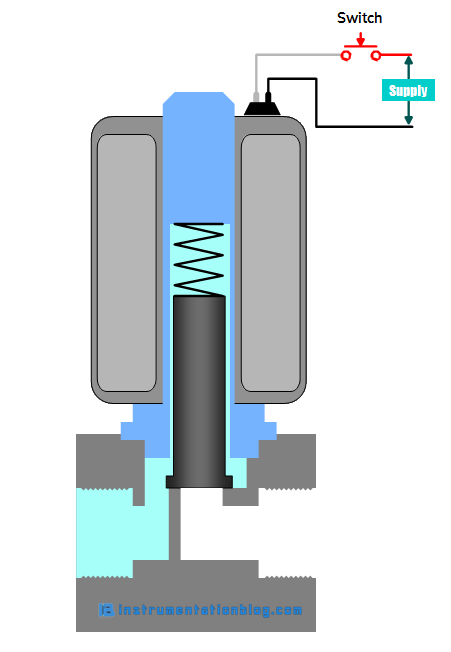
Where are solenoid valves used?
Solenoid valves are used in a wide range of applications such as,
⇒ Water Supply and Treatment
⇒ Machine and Plant engineering
⇒ De-dusting Systems
⇒ Bag Filter Systems
⇒ Building Services
⇒ Refrigeration and Cooling Plants
⇒ Large Heating System and Climate control
⇒ Air Compressors
⇒ Fuel Supply
⇒ Firing Systems
⇒ Oil and Gas Control
⇒ Control of cleaning processes
⇒ Material Filling Systems
Types of Solenoid Valves
Direct Acting Solenoid Valve
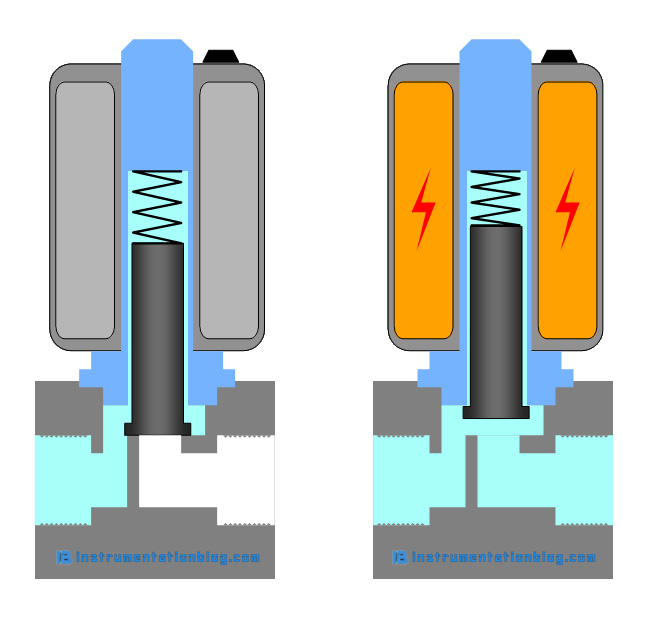
The direct-acting solenoid valve is generally used with small flow-rate applications. The working principle of a direct-acting solenoid valve is,
When there is power at the electrical coil it generates an electromagnetic field and attracts the plunger to the upward side. This will open the orifice and allows the media to flow through it.
In this type of solenoid valve, maximum operating pressure and flow rates are directly related to the orifice diameter. Therefore it generally used with low flow-rates applications.
A direct-acting solenoid valve does not need any pressure or pressure difference to operating, so it can also be used with zero pressure and negative pressure.
Indirect Acting (Servo or Pilot Operated) Solenoid Valve
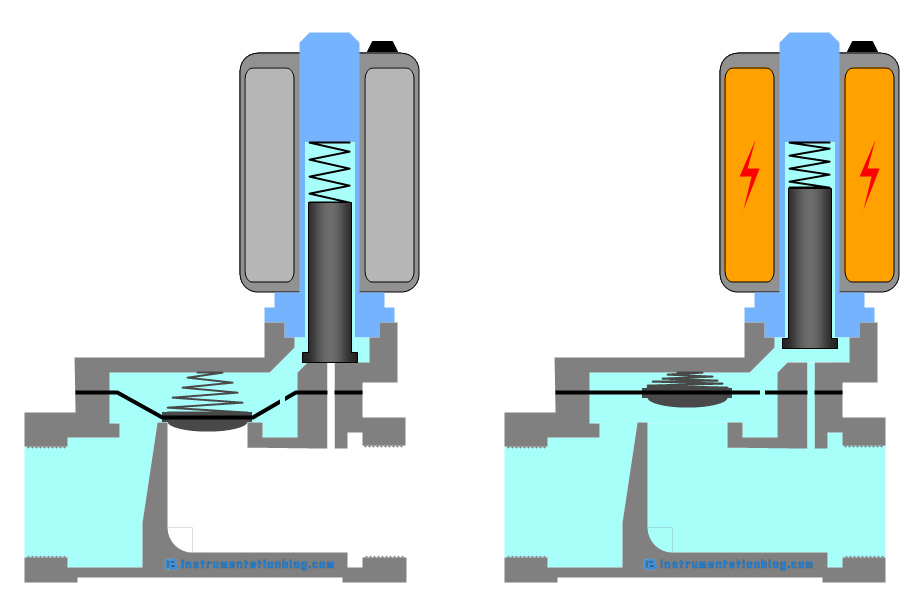
Indirect acting solenoid valve uses a small pressure difference of the medium over the inlet and outlet ports to open and close the valve.
An indirect acting solenoid valve is also known as a servo-operated or pilot operated valve. Generally, it requires a minimum pressure difference of around 0.5 bar to operate.
There is a rubber membrane between the inlet and outlet ports as shown in the figure. There is a low-pressure port at the upper chamber of the membrane, this port is blocked at the ideal condition by the plunger.
When the solenoid gets energized, the orifice opens which causes a pressure drop at the membrane. Due to this pressure difference on both sides of the membrane, it will be lifted up and the medium can flow from inlet to outlet port.
This mechanism of rubber membrane chamber acts as an amplifier, a small solenoid can control a large flow rate. Indirect acting solenoid valves are used to control a large flow rate.
Semi-Direct Acting Solenoid Valve
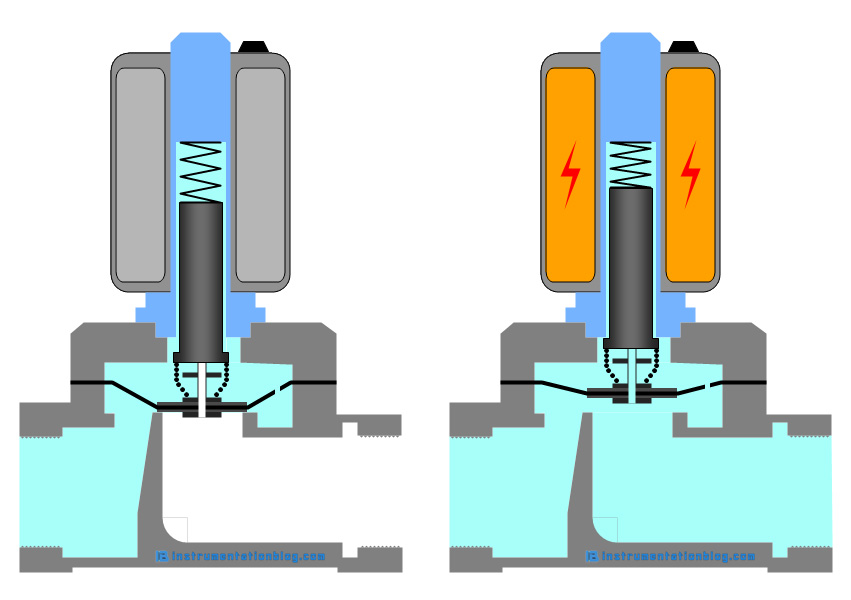
The semi-direct acting solenoid valve has the properties of both direct and indirect-acting solenoid valve. Due to this it can operate from zero pressure and handle a large flow rate.
The design of the semi-direct acting solenoid valve is nearly the same as the indirect-acting solenoid valve. It has a rubber membrane with a small orifice and pressure chambers on both sides of the membrane.
The only difference here is that the solenoid plunger is directly connected with the membrane. When the solenoid gets energized, the plunger is lifted up and the material starts flowing. Also, this causes a second orifice at the membrane which has a small diameter than the main orifice to open up. This creates a pressure drop at the chamber above the membrane, this also lifts up the membrane.
The combined properties of both direct and indirect-acting solenoid valve result in the semi-direct acting solenoid valve to operate from zero pressure and handle relatively large flow rates.
Selection Criteria of Solenoid Valve
1. Type of Solenoid Valve
It depends on your application whether a 2-way or 3-way solenoid valve required.
2. Housing Material
It depends on the medium in which valves are being used. We need to check the chemical properties and temperature of the media. Generally, brass is used. Stainless steel has a good chemical, temperature, and pressure resistance.
3. Seal Material
Seal materials should be selected based on the chemical properties and temperature of the media. NBR, EPDM, FKM(Viton), and PTFE(Teflon) are the common options.
4. Operating Voltage
The solenoid valves are available with both AC and DC operating voltages. Choose as per your supply availability.
5. Valve Function
You can select either a normally open or a normally close as per your application. The most commonly used solenoid valves are normally open types.
6. Operating Type
There are direct-acting, indirect-acting, and semi-direct acting types of valves.
7. Temperature
Valves material should withstand a minimum and maximum temperature wherever it is installed.
8. Response Time
The response time is the time to take a valve from open to close or close to open position. Direct-acting solenoid valves are much quicker than the indirect-acting or semi-direct acting solenoid valves.
I hope you like this article about What is Solenoid Valve? How does the solenoid valve work? What does a solenoid valve do?
If you found any topic that I missed out in this article, then please comment on it in the comment section below. I will try to cover it.
Reference: Tameson
Must-read Articles,
⇒ Different Types of Valves used in Instrumentation.
⇒ What is a Control Valve? How does it work?
You can read more articles about Electrical and you can also find books that boost your knowledge in the field of Instrumentation ⇒
Thanks for reading!
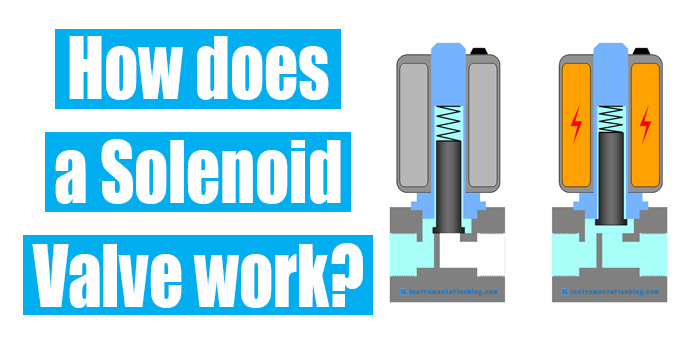
Interesting article! Solenoid valves are widely used in a variety of industries and home appliances. It is used in a variety of applications ranging from industrial to irrigation systems where it aids in automatic control. It is used to control water flow in home appliances such as dishwashers and washing machines.